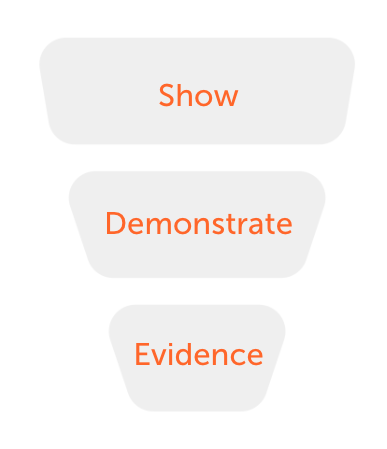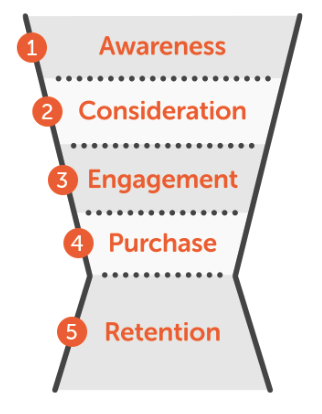Research shows that many marketing managers and executives are frustrated with the constant budget restraints and pushback that they face when trying to plan their company’s marketing. They are unsure of how to justify their marketing spend to their boss.
Is this you? If so, we’re here to tell you that it doesn’t have to be this way.
In this webinar, Danni and Fran will discuss the common concerns and priorities of bosses or upper management when it comes to marketing spend and how to justify your marketing spend to your boss.
We’ll also share some proven strategies for aligning marketing objectives with the overall business strategy, proving the ROI of your marketing efforts, and building strong relationships with your boss and stakeholders.
By the end of this webinar, you’ll have the tools and knowledge you need to justify your marketing spend to your boss and get the resources you need to succeed.
Webinar Video
Slides
Overview
1. Building relationships and collaboration
Regular reporting: Keep your boss involved. Ensure you’re keeping your boss notified of ongoing marketing activity, including results and upcoming plans through regular reporting. This could be from monthly or even weekly reporting.
Listen and incorporate feedback: Actively seek feedback and demonstrate how you’ve incorporated their suggestions and concerns into your marketing proposal.
Align with business priorities: Marketing is here to support the success of the company so show your marketing efforts are aligned with the overall business objectives.
Collaborate across departments: It’s the age-old tale of marketing versus sales, but it’s important to work and collaborate with other departments. You can do this by involving other departments in the process, and asking them what their department priorities would be and how you can help achieve these goals.
But remember, don’t make promises you can’t keep!
2. Anticipating and addressing objections
As marketing managers we expect objections when trying to justify your marketing spend, but here is how you can deal with them:
Preemptive communication: Anticipate and address potential objections proactively. To do this remember to look at it from their point of view.
Managing risk: Show how you plan to minimise risks and react to unexpected challenges. Be flexible, this is a great opportunity to show your thought process.
Cost-benefit analysis: Demonstrate how the benefits outweigh the risks. Analyse the pros and cons of your marketing strategy, and show the next steps depending on whether the project is a success or not.
Testing and pilots: Suggest starting with smaller-scale tests to gather data and validate the potential success of larger initiatives.
3. Budget allocation and resource planning
As a marketing manager, you’ll often face the challenge of justifying your budget allocation to higher-ups.
Here’s how to do it:
Data-driven budgeting: Base your budget allocation on historical performance, market trends and data-driven insights. If something worked well or didn’t last year, bring the evidence to support your new proposal. If it didn’t work explain why and what you would do differently.
Cost-benefit analysis: Conduct a cost-benefit analysis for each marketing initiative. Break down each campaign and section, and what each will cost. Don’t just show the overall cost. Compare the potential returns against the investment required to demonstrate the value of the expenditure. And don’t forget to include the cost of the software too!
Prioritise high-impact activities: Focus on marketing activities that have a high potential to impact business goals and objectives. Justify why investing more in these areas will yield better results.
Flexibility and scalability: Demonstrate that your budget is flexible and adaptable to changes in the market or business conditions. Show that you can scale up or down based on the results and feedback.
4. Developing a results-oriented marketing plan
A well-defined marketing plan is the foundation for justifying your marketing spend to your boss.
A results-oriented marketing plan should include:
Clear objectives: Set specific, measurable, attainable, relevant, and time-bound (SMART) objectives aligned with the business goals. This clarity helps in focusing efforts and resources on specific goals rather than pursuing vague or general ambitions.
A defined target audience: Identify your target audience and understand their needs to tailor marketing efforts effectively. You should know your audience inside and out. Creating audience personas is the best way to do this.
Strategies and tactics: Outline the marketing strategies and tactics you will employ to achieve your objectives. Think about the goals you have and how you plan to get there.
For example, if the goal is brand awareness how do you achieve that? Look at what metrics relate to supporting this goal and then how you can improve them.
Budget allocation: Allocate your marketing budget based on the strategies and expected outcomes. Justify how each allocation contributes to achieving the overall objectives. Remember those business goals? Don’t forget to refer to them! Bringing data to back up how this has worked in the past for your company or for others. This will demonstrate how you’re prioritising the budget
Contingency plans: Anticipate potential challenges and have contingency plans in place to address them effectively. Show management you have a backup plan in case of things not going as expected.
5. Defining key metrics for marketing success
Use your metric to show, demonstrate and evidence.

Show: Begin by showing how your marketing proposal supports the vision, mission, and strategy of your organisation. And how it contributes to the key performance indicators (KPIs) and metrics that matter to senior management and executives.
Demonstrate: How it will help to achieve any other relevant business outcomes.
Evidence: Finally, use data and evidence to back up your claims and show the return on investment (ROI) of your marketing budget and plan.
Demonstrate marketing’s impact on business growth, profitability, and cost-effectiveness with example metrics such as:
Website traffic: This metric measures the number of visitors who come to your website. It’s a good indicator of how well your marketing is reaching your target audience.
Leads generated: This measures the number of people who have expressed interest in your products or services. It’s a good indicator of how effective your marketing is at generating interest in your business.
Sales closed: This shows the number of people who have actually purchased your products or services. It’s the most important metric for measuring the ROI of your marketing efforts.
Cost per acquisition (CPA): This measures the amount of money you spend to acquire a new customer. It’s a good way to compare the effectiveness of different marketing channels.
Customer lifetime value (LTV): This metric measures the total amount of revenue you can expect from a customer over their lifetime. It’s a good way to measure the long-term profitability of your marketing efforts.
It’s easier to go to the table to ask for a larger budget if you have the data to show how your marketing budget impacted revenues last year.
Data doesn’t always need to be factual numbers to justify your marketing spend
Asking the top salesperson for their feedback will only add to your case when presenting to management.

Above is your sales funnel, you need to make connections of where your client is in their buyer journey by using your metrics and how you can move them into the next phase. Top-of-funnel KPIs include brand awareness and demand generation, while bottom-of-the-funnel KPIs are revenue/ sales growth, retention and lifetime value.
6. Presenting data and analytics to justify spend
The success of justifying your marketing spend relies heavily on how you present data and analytics to your boss.
To ensure you get the marketing budget you want here are some tricks to presenting your data:
Visual storytelling: is a way to make complex information easy to understand. It uses pictures like charts, graphs, and infographics to show data in a clear and engaging way. This helps people get your message quickly. Visual storytelling also makes information more memorable because our brains remember pictures better than just words. It’s a great way to get your point across, whether you’re giving a presentation, creating marketing materials, or sharing information.
Highlight key insights: to get the best results from your marketing, focus on the most important data that shows how your marketing is helping the business.
Benchmarking and comparison: help compare the current performance with past data or industry benchmarks to provide context and show improvements.
Use real examples: Share real-life success stories and case studies from your own or other companies to demonstrate the potential impact of marketing spend.
Actionable recommendations: Offer actionable insights based on the data to show that you not only analyze results but also use the information to make informed decisions.
It’s important to look at what the competition is doing and how they’re spending their money. You can use tools such as:
- Social Ad Libraries like Facebook Ad Library where you can look at what social ads your competitors are doing.
- Rival IQ provides social media analytics for both your own pages and competitors.
- Screaming Frog is a website crawler that helps you improve onsite SEO by auditing for common SEO issues.
- Similar Web is a tool that estimates the total amount of traffic different websites get. It allows you to see competitors’ top traffic sources.
7. Leveraging technology and automation
Utilising tools can make a significant difference in justifying your marketing spend to your boss!
Marketing analytics tools: There are lots of different online tools to help you analyse your marketing efforts. Utilise these to gather and analyse data, providing insightful metrics to support your justifications when presenting your marketing proposal.
Automated reporting: Most platforms have a report automation tool nowadays. Make use of them! They will save you time and help with consistent reporting.
A/B testing: If you’re unsure of which direction to go, A/B testing is the best way to decide. It will also give you data to back up your claims.
CRM integration: A CRM is the best way to track leads, conversions, and customer interactions effectively with marketing efforts.
Chat GPT/Bard: AI can be a complementary tool for your business. They can help assist you and save time, especially when researching or creating content. But don’t rely on them! Make sure they are just assisting you.
8. Include case studies and examples
Make your justifications more convincing and relatable with case studies and examples.
When justifying your marketing spend to your boss make sure you include case studies that:
Align with your industry: Find case studies from companies within your industry to demonstrate relevance and applicability.
Show Tangible Results: Choose case studies that clearly illustrate how marketing spend directly impacted business outcomes.
Include Similar Challenges: Highlight case studies that faced challenges similar to those you might encounter, and show how they overcame them.
Quantify Results: Use data and metrics from case studies to back up your arguments and demonstrate the potential return on investment.
In summary…
To justify your marketing spend to your boss you need to:
Focus on the results. Include specific results of a previous marketing campaign.
Use data to back up your claims. Don’t just say that your campaign was successful, show your boss the data that proves it.
Be clear and concise. Your proposal should be easy to understand and follow.
Highlight the key takeaways. What are the most important things that your boss should take away from your proposal?
You should now know 8 strategies to help you justify your marketing spending to your boss. If you’re a Marketing Manager in need of some support our marketing consultation service, Alfred is here to help you, get in touch.



